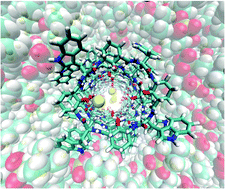Molecular dynamics simulations for designing biomimetic pores based on internally functionalized self-assembling α,γ-peptide nanotubes†
Abstract
A molecular dynamics study on internally functionalized peptide nanotubes composed of α- and γ-amino acids self-assembled in lipid bilayers is presented. One of the main advantages of peptide nanotubes composed of γ-amino acids is that the properties of their inner cavities can be tuned by introducing different functions on β-carbon of the γ-amino acid. In the work described here we studied the effect of the presence of different numbers of hydroxyl groups in different positions in the lumen of these channels when they are inserted into a lipid bilayer and assessed how they affect the structural and dynamic behavior of the modified peptide nanotubes as well as the transmembrane transport of different ions. The results provided atomic information about the effect of polar groups on the dynamic, structural and transport properties of this type of peptidic channel upon insertion into lipid bilayers, projecting a promising future for their use as biomimetic channels when properly inner-derivatized. Furthermore, the chemical versatility of the hydroxyl groups in the lumen of the peptide nanotubes would enable appealing applications for these channels, such as a controlled method for the activation/inactivation of the transmembrane transport along the nanopore.


 Please wait while we load your content...
Please wait while we load your content...